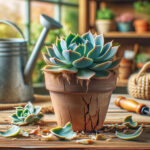Introduction to Echeveria ‘The Rose’
Welcome to the enchanting world of Echeveria ‘The Rose,’ a succulent that’s as mesmerizing as it is easy-going. Picture this: imagine composing a symphony with nature’s finest notes, where each rosette resembles the delicate swirl of a rose in full bloom. That’s Echeveria ‘The Rose’ for you – a botanical masterpiece that sings to the tune of simplistic elegance and resilience.
Originating from the rocky terrains of Central America, the Echeveria ‘The Rose’ has traveled far and wide to grace the homes and gardens of plant connoisseurs across the globe. Its charm lies not only in its floral mimicry but also in its captivating palette of colors that can make any plant lover’s heart skip a beat. With its plump, water-storing leaves, it’s a testament to nature’s ingenuity, thriving where few other plants dare to set root.
Imagine the joy of owning a piece of nature’s art that is so versatile in its care. Echeveria ‘The Rose’ is the perfect starter for those looking to dive into the succulent world without fearing the commitment that comes with more finicky green companions. It radiates sheer beauty year-round, asking for little but giving back so much. For more insights on caring for this splendid variety, check out this external source on Echeveria ‘The Rose’ care.
Whether you are an experienced gardener or just starting, Echeveria ‘The Rose’ is a delightful addition to any plant collection, effortlessly blending in with modern minimalist décor or outside in a rock garden bursting with life. This variety’s symphony is sure to continue, with each rosette a note that plays to the calming rhythm of nature itself. What are you waiting for? It’s time to cultivate your own succulent symphony with Echeveria ‘The Rose’!
The Alluring Aesthetics of ‘The Rose’
An encounter with Echeveria ‘The Rose’ is akin to stumbling upon a secret garden—a haven where the symphony of succulents crescendos with the presence of this stunning specimen. With its impeccable rosette formation mirroring the finesse of a masterfully sculpted sculpture and a color palette that evokes the painted skies of dawn, ‘The Rose’ stands apart, enveloping the senses in its mesmerizing grace.
The rosettes of ‘The Rose’ are not merely structures but stories in themselves, eloquent in their spiral embrace. Each leaf, plump and inviting, is carefully arranged much like the petals of its namesake. In the right light, their tips dance with shades of blush—a spectacle of nature’s artistry, inspiring onlookers to pause and appreciate the simple complexities of the botanic world. It’s easy to gaze upon these succulents and imagine a life-size garden of them, echoing the splendor of ‘The Rose’ in grand scale.
It’s not just the eye that ‘The Rose’ enchants but the hands of cultivators, too. Drawing gardeners with a penchant for the unique, the plant’s distinctive coloration—ranging from a deep, slate-blue to soft pastel pinks—flourishes under a caring touch and considerate placement. This living artwork enriches terraces and indoor spaces alike, its color intensifying with the kiss of the sun’s rays, as featured in this comprehensive care guide.
Of course, witnessing ‘The Rose’ in isolation hardly does justice to its potential. Imagine it juxtaposed against the earthy greens of other succulents or the stony backdrop of an alpine rockery, narrating a tale of contrasts and harmonies. For those eager to delve deeper into the captivating world of succulents, explore our detailed examination of succulent varieties that pair exquisitely with ‘The Rose.’
And for those hands-on enthusiasts, craving the thrill of propagation and the bloom of new rosettes, ‘The Rose’ can become a progenitor to a lineage of elegance. As if composing a botanical movement, one can draw inspiration from the insightful tutorials available online—like the one encapsulated in this video:
With care, patience, and creativity, Echeveria ‘The Rose’ can be the centerpiece of a succulent symphony, a living ode to aesthetic perfection and horticultural achievement. Its alluring aesthetics are not exclusive—it shares with each admirer the joy of cultivation, the beauty of growth, and the innate artistry of the natural world.
Essential Care for Echeveria ‘The Rose’
Imagine a symphony of succulents on your windowsill, each note created by the plump, rosette-shaped leaves of Echeveria ‘The Rose’. To ensure your plant hits every note with perfection, it’s essential to understand its crescendo of care needs, from sunbathing in the morning light to sipping delicately on droplets of water.
Let There Be Light!
Begin with the sunlight serenade. Echeveria ‘The Rose’ adores a good light show. Think of it like a sun connoisseur—it needs bright but indirect light to flourish. Direct the spotlight away from the scorching afternoon rays to avoid sunburns. Instead, provide a gentle, diffuse light as if it’s basking in the glow of a sunrise. A north or east-facing windowsill can be the perfect stage for this radiant performance.
Watering Rhythm
The next part of the routine is the watering waltz—a delicate dance that must be carefully choreographed. Too much water and the roots will drown in sorrow. Too little, and the leaves will wilt in despair. Aim for a watering schedule that lets the soil dry out completely between encores. Use your finger as a natural moisture meter—if it feels dry a couple of inches down, it’s showtime for the watering can.
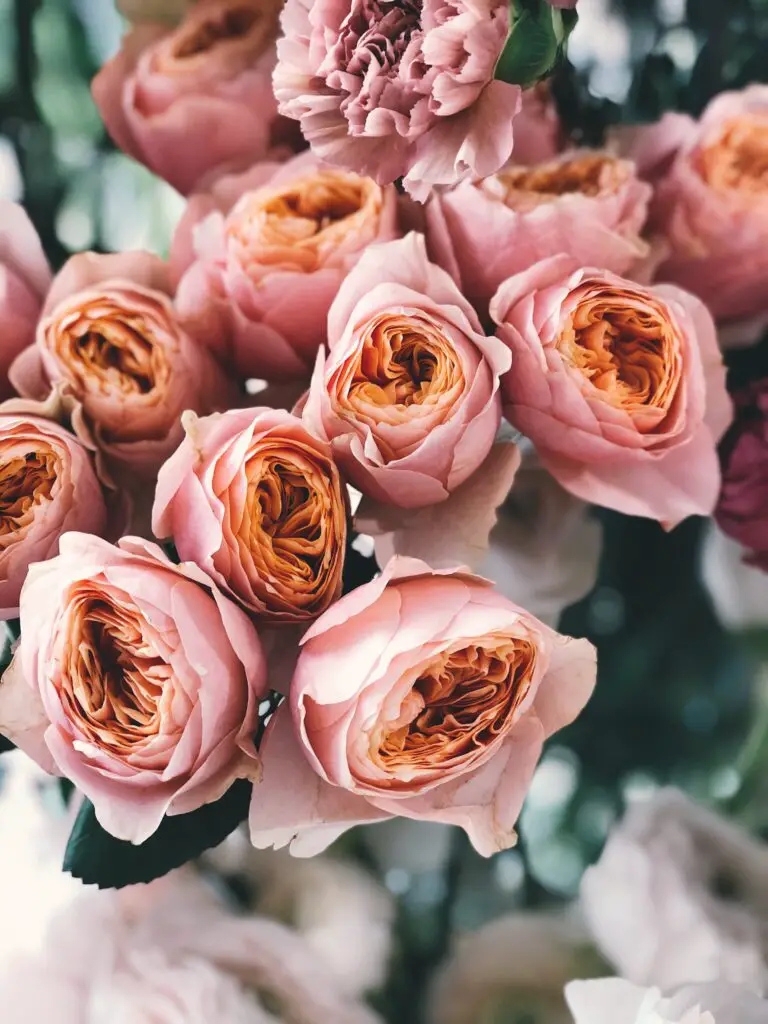
Soil Composition Solo
Accompanying the watering waltz is the soil composition solo. Your Echeveria ‘The Rose’ needs the right mix to perform well—think a blend of potting soil with extra perlite or pumice for that oh-so-crucial drainage. The roots of the Echeveria prefer to stay high and dry, rather than waterlogged. It’s like preparing the stage for an open-air concert where the water drains away as smoothly as the final note of a sonata.
Setting the Temperature and Humidity Stage
The final act is about setting the stage with the ideal temperature and humidity. Our succulent star is not a fan of the cold; it prefers the spotlight to be warm, ideally between 65-70°F (18-21°C). When the temperature drops below 50°F (10°C), it’s like sending shivers down the spine of our green performer. Meanwhile, it handles humidity with the grace of an experienced actor, adapting to most indoor conditions without fuss.
To dive deeper into the world of succulent care, explore our ultimate guide to succulent care, where you can learn more about nurturing your botanic orchestra.
Propagating Your Echeveria ‘The Rose’
If you’ve ever admired the rosette splendor of Echeveria ‘The Rose’, you might be thrilled to discover that propagating this succulent beauty is as enchanting as its bloom. Whether you’re an avid collector or a beginner charmed by its elegance, multiplying your ‘The Rose’ collection can be a symphony of joy. Let’s dive into the mesmerizing world of propagating Echeveria ‘The Rose’.
Leaf Propagation: Like a Leaf on the Wind
Imagine each plump leaf as a potential new plant – a clone of its parent, ready to take root and grow. Gently wiggle a healthy leaf from the stem, ensuring a clean break. Allow the leaf to callous over for a few days, creating a protective barrier. Then place it on well-draining soil, misting lightly. In a few weeks, tiny pink roots and a miniature rosette will emerge, a true testament to nature’s resilience.
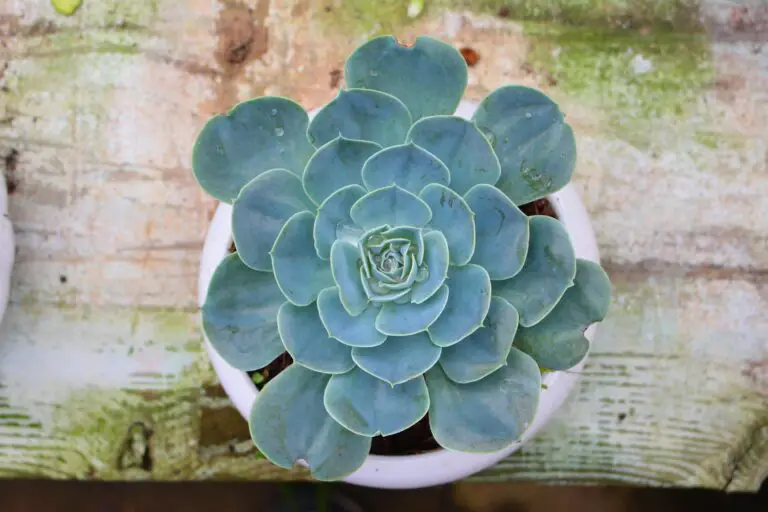
Offsets: Little Rosettes Taking Center Stage
‘The Rose’ is generous, producing offsets, or “pups”, at its base, which cluster like a bouquet. With a careful snip, you can separate these baby rosettes once they have a few roots of their own. Plant them in their own pots, and watch as they grow, gradually unfolding their layers like the slow opening of a flower on a warm spring day.
Cuttings: Snip and Grow
For those more established ‘The Rose’ succulents, stem cuttings are your ticket to new growth. Take your shears and cut a healthy stem, allowing the cut to callous. Plant the stem cutting into soil and witness the magic as it establishes roots and eventually erupts into a full-grown plant. The joy of watching a cutting transform reminds us of the simple pleasures of gardening – nurturing a small part of nature and seeing it flourish.
Whether you’re propagating by leaves, offsets, or cuttings, Echeveria ‘The Rose’ offers a delightful experience that harmonizes with the rhythm of nature. It’s a wonder to observe each method’s subtle differences as they play their part in the cycle of growth. With patience and care, you’ll soon have a collection that sings with the beauty of ‘The Rose’.
Addressing Common Pests and Problems
Imagine this: your Echeveria ‘The Rose’ is thriving, spreading its rosette petals like a symphony of succulent splendor. But wait—what’s that tiny white spec on the leaf? Oh no, it’s a mealybug! And there, a cluster of aphids staging a takeover on the stem. Don’t fret! It’s time to turn the tide against these common pests.
First, let’s unmask our culprits. Mealybugs look like tiny cotton puffs, deviously sapping the life from your plant. Aphids, those green or black critters, are equally nefarious, clustering in numbers and causing mayhem among the leaves. Now, onto the battle strategies. A simple yet effective solution is a mixture of mild dish soap and water—your green thumb’s secret weapon. A soft spray will detach and dissolve these pests without harming ‘The Rose’.
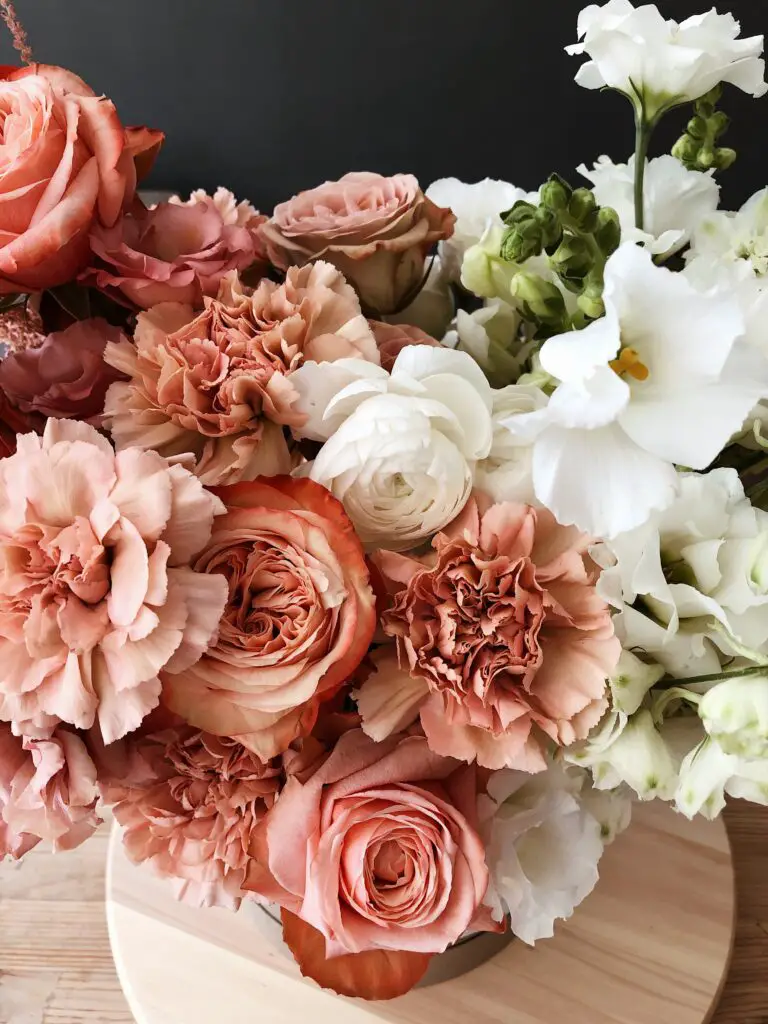
Real-life example alert: Jane Doe, a fellow ‘The Rose’ aficionado, noticed her plant losing its vibrant luster. Upon investigation, a gang of aphids was caught red-handed. A few spritzes later, her ‘The Rose’ was on the mend, and Jane has been aphid-free since!
When Pests Aren’t The Only Problem
Unfortunately, it’s not just the bugs we need to worry about. Fungal diseases can swoop in, turning ‘The Rose’ from a succulent sensation into a wilted wallflower. Prevention is your best defense. Ensure good air circulation, don’t overwater, and keep those leaves dry. If you do spot signs of disease, like black spots or rot, it’s time to get surgical. Trim away the affected areas, and consider a fungicide as backup—but always as a last resort!
Remember Neil’s nightmare? His ‘The Rose’ caught a fungal disease after a surprise shower left it too damp. Quick to act, he pruned the soggy sadness away, adjusted his watering habits, and now Neil’s ‘The Rose’ is the belle of the ball once again.
Keep these tips in mind, and your Echeveria ‘The Rose’ will continue to be the centerpiece of your succulent chorus, resilient against the tiny terrors that threaten its performance. With vigilance and the right care, pests and diseases will be but a mere intermission in the grand opera of gardening.
Styling with Echeveria ‘The Rose’: Decor Tips
If you’re looking for a stylish and low-maintenance addition to your living space, Echeveria ‘The Rose’ is a perfect choice. Its rosette pattern resembles a blooming flower, making it an eye-catching piece in any decor setting. But how do you integrate this succulent delight into your space? Let’s dive into some creative decor tips that will have your friends marveling at your green-thumb prowess.
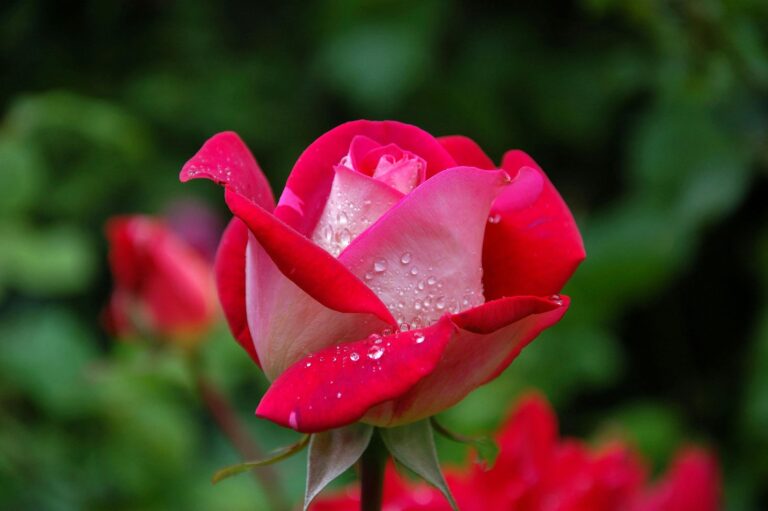
First off, consider the power of simplicity. A singular ‘The Rose’ in a white ceramic pot can be a statement piece on a coffee table or bookshelf. The contrast between the plant’s lush green leaves and the pot’s crisp color accentuates the plant’s beauty. Plus, the simplicity of the setup allows ‘The Rose’ to truly shine, proving that sometimes less is more.
For those who appreciate a fairy-tale essence, why not create a terrarium? Layer pebbles, activated charcoal, and soil in a glass container, and nestle your Echeveria ‘The Rose’ inside. Accessorizing with miniature figurines, or a dash of colorful moss, can turn your terrarium into a miniature enchanted world. It’s a fantastic conversation starter and adds a sprinkling of magic to any room.
Lastly, bringing ‘The Rose’ outdoors can invigorate your succulent garden with a pop of structured beauty. Planted among a sea of succulents, Echeveria ‘The Rose’ stands out with its symmetrical shape and stunning foliage. Imagine a rockery where they line a winding path, greeting visitors with a charming bouquet of greenery. Or utilize them as natural art by planting them in geometric patterns – think succulent spirals or concentric circles – to create a living mosaic that changes with the seasons.
FAQs – Your Questions About Echeveria ‘The Rose’ Answered
Are you humming to the tune of growing your own Echeveria ‘The Rose’, but find yourself hitting a few sour notes along the way? Never fear, fellow green-thumbed symphony conductor! Let’s strike the right chord with answers to your most pressing questions about this melodious succulent!
Why is my Echeveria ‘The Rose’ changing color?
It’s perfectly natural for ‘The Rose’ to change its tune when it comes to color. Think of it as a mood ring: Bright, direct light can bring out more vibrant pinks and reds, while softer light coaxes out a bluish-green serenade. Just as an orchestra adjusts to the conductor’s baton, your Echeveria ‘The Rose’ responds to its environment. If the color change comes with soft, mushy leaves, though, you might be overwatering—cut back to restore its proper pitch!
How often should I water my succulent symphony?
Imagine each watering session as a grand crescendo, building up only when the soil is as dry as a concert hall before doors open. Generally, this means a deep soak every two weeks—but always check the soil first. It’s like knowing when to hold the applause until the end of the piece!
What’s the best potting mix for Echeveria ‘The Rose’?
‘The Rose’ prefers a solo on center stage with a well-draining mix—think cactus or succulent soil—that allows it the freedom to bask in its soloist glory. Add perlite or pumice for extra aeration, akin to the breath of life that wind instruments provide to a musical ensemble.
My Echeveria ‘The Rose’ seems a bit off-beat. What could be wrong?
Even the most harmonious plants can hit a wrong note now and then. If ‘The Rose’ drops leaves unexpectedly or looks wilted, it might be trying to tell you something. Check for root rot, pests, and ensure that your lighting is ‘encore’ worthy. The right conditions will have your succulent basking in the spotlight again in no time.
Can I propagate my Echeveria ‘The Rose’ to create an ensemble?
Absolutely! When your ‘The Rose’ starts to produce pups or offsets, it’s like a standing ovation. With careful separation and the right soil conditions, you can propagate your very own chorus of rosettes. Before you know it, you’ll have a whole garden of succulent symphonies!
Remember, every plant is like a unique member of an orchestra; just as a violinist plays differently from a cellist, your Echeveria ‘The Rose’ will require its own special care. Keep these tips in tune, and you’ll have a flourishing floral medley that sings to the soul!
